- SP 1 (Yǐn Bái, 隐白)
- SP 2 (Dà Dū, 大都)
- SP 3 (Tài Bái, 太白)
- SP 4 (Gōng Sūn, 公孙)
- SP 5 (Shāng Qiū, 商丘)
- SP 6 (Sān Yīn Jiāo, 三阴交)
- SP 7 (Lòu Gǔ, 漏谷)
- SP 8 (Dì Jī, 地机)
- SP 9 (Yīn Líng Quán, 阴陵泉)
- SP 10 (Xuè Hǎi, 血海)
- SP 11 (Jī Mén, 箕门)
- SP 12 (Chōng Mén, 冲门)
- SP 13 (Fǔ Shè, 府舍)
- SP 14 (Fù Jié, 腹结)
- SP 15 (Dà Héng, 大横)
- SP 16 (Fù Āi, 腹哀)
- SP 17 (Shí Dòu, 食窦)
- SP 18 (Tiān Xī, 天溪)
- SP 19 (Xiōng Xiāng, 胸乡)
- SP 20 (Zhōu Róng, 周荣)
- SP 21 (Dà Bāo, 大包)
The foot taiyin spleen channel has 21 bilateral points: 11 on the medial side of the lower limb; 1 at the groin; the other 9 on the stomach and chest. The first point is on the medial side of the big toe, SP 1 (yǐn bái); the last is on the hypochondrium, SP 21 (dà bāo). Points of this channel are responsible for disorders of the stomach, intestinal system, and the running course of the channel.
SP 1 (Yǐn Bái, 隐白)
Jing-well point
Location. On the great toe, medial to the distal phalanx, 0.1 cun proximal-medial to the medial corner of the toenail at the intersection of a line along the medial border of the nail and one along the base of the nail (Pic. 3-26).
Actions. Regulate menstruation, control blood, invigorate the spleen, and restore yang.
Indications. Profuse menstruation, fooding and spotting, spitting of blood, epistaxis, blood in urine and stool; abdominal distention, violent diarrhea, vomiting, hernia; psychosis, dream-disturbed sleep, nightmares, syncope, dysphoria, susceptibility to sorrow, chronic infantile convulsion, fainting; chest distention, cough, vomiting, panting, heart pain; pain in the toes; and mental disorders such as depression and mania, as this is one of the thirteen ghost points.
Manipulation. Acupuncture: 1. Needle superficially 0.1~0.2 cun; there will be local soreness. 2. Bleed with a three-edged needle to treat unconsciousness, choking sensation, cough, and asthma. Moxibustion: Use 3~7 cones of cone moxibustion or 5~20 minutes with a moxa stick to stop bleeding.
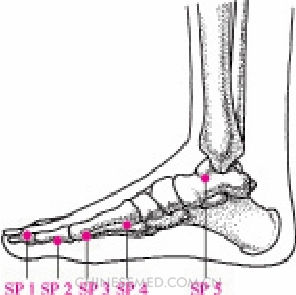
Precautions. 1. Be careful if using acupuncture during pregnancy. 2. Scarring moxibustion is not advisable.
Annotation. The point appeared in The Spiritual Pivot (Líng Shū, 灵枢). Yǐn means hidden; bái means white, the color of metal. This is the jing-well point of the foot taiyin, which belongs to earth, and earth is the mother of metal in the fve phases. This point is where the foot taiyin qi originates and hand taiyin metal qi is hidden.
Modern clinical observation and research. In a case series on menorrhagia, acupuncture (n=31) and moxibustion (n=33) treatment groups were compared. Beginning on the second day of menstruation, both groups were treated daily for three days at RN 4 and bilaterally at SP 1 and SP 6. Both improved significantly in menstrual amount, duration, and color by the three-month follow up.1
SP 2 (Dà Dū, 大都)
Ying-spring point
Location. On the great toe at the border between the red and the white fesh in the depression distal to the first metatarsophalangeal joint (Pic. 3-26).
Actions. Purge heat, relieve pain, invigorate spleen, and harmonize the middle jiao.
Indications. Abdominal distention, stomachache, diarrhea, constipation, abdominal pain, indigestion, purulent bloody stool; convulsion in children, insomnia due to dysphoria; swollen and painful tip of toe, heavy sensation in the body, swelling and cold limbs; febrile disease with absence of sweating, heart pain, fainting, common cold.
Manipulation. Acupuncture: Needle perpendicularly 0.3~0.5 cun. There will be local soreness. Twirl to reinforce or reduce. Moxibustion: Use 1~3 cones of cone moxibustion, or 5~10 minutes with a moxa stick.
Precautions. Moxibustion is prohibited during pregnancy and 100 days after postpartum. Scarring moxibustion is inadvisable.
Annotation. The point appeared in The Spiritual Pivot (Líng Shū, 灵枢). Dū means capital. There was an ancient saying, ‘four counties and four capitals’. The spleen governs the four limbs, and dū refers to the spleen as the earth in this instance.
SP 3 (Tài Bái, 太白)
Shu-stream point; yuan-source point
Location. On the medial aspect of the foot at the border between the red and white fesh in the depression proximal to the first metatarsophalangeal joint (Pic. 3-26).
1 Liu, PY. Clinical observation on the effect of acupuncture on 64 patients with menorrhagia针灸治疗月经过多症64例. Shaanxi Chinese Medicine. 2001; 22(6): 364.
Location method. With the patient sitting straight with the foot hanging, the point is 1 cun posterior and inferior to the small head of the first metatarsal.
Actions. Invigorate the spleen, harmonize the stomach, clear heat, and resolve dampness.
Indications. Stomachache, abdominal distention, abdominal pain, borborygmus, vomiting, diarrhea, dysentery, anorexia, constipation, infantile malnutrition, belching, indigestion; flooding and spotting, leukorrhea, amenorrhea, menstrual irregularities, hypogalactia; foot pain, swollen foot; consumptive disease, cough, collapse, heart pain, slow pulse, swelling and pain in chest and ribs, paralysis, heaviness of the body, joint pain.
Manipulation. Acupuncture: Needle perpendicularly 0.3~0.5 cun; induce local soreness. Moxibustion: Use 3~5 cones of cone moxibustion, or 5~10 minutes with a moxa stick.
Precautions. Scarring moxibustion is inadvisable.
Annotation. The point appeared in The Spiritual Pivot (Líng Shū, 灵枢); it is the earth point of the spleen channel. Tài means big or beginning; bái means white. Earth generates metal, which is white. The point is considered to be where metal qi originates.
SP 4 (Gōng Sūn, 公孙)
Luo-connecting point; confuence point of the chong mai
Location. On the medial aspect of the foot anteroinferior to the base of the first metatarsal bone at the border between the red and the white fesh (Pic. 3-26).
Location method. The point is posterior to the medial aspect of the great toe, anterior and inferior to the medial aspect of the base of the first metatarsal bone. Find it in the next depression by pushing proximally along the spleen channel from SP 3 (tài bái).
Actions. Invigorate the spleen and stomach, and regulate chong mai and ren mai.
Indications. Vomiting, abdominal pain, hiccup, regurgitation, dysphagia, stomachache, diarrhea, borborygmus, indigestion, dysentery; fainting due to hemorrhage in females, retention of placenta after birth, dysmenorrhea, menstrual irregularities, leukorrhea; qi counterflow, abdominal urgency; epilepsy, malaria, vexation, insomnia, mania, delirious speech, somnolence; foot pain, swollen foot, talipes varus.
Manipulation. Acupuncture: Needle perpendicularly 0.5~0.8 cun. Deep insertion can reach KI 1 (yŏng quán). Local soreness should spread to the sole of the foot. Moxibustion: Use 3~5 cones of cone moxibustion, or 10~20 minutes with a moxa stick.
Precautions. Direct moxibustion is inadvisable.
Annotation. The point appeared in The Spiritual Pivot (Líng Shū, 灵枢). It is named for the Yellow Emperor, Xuan Yuan; gōng sūn is his surname.
SP 5 (Shāng Qiū, 商丘)
Jing-river point
Location. On the medial aspect of the foot anteroinferior to the medial malleolus in the depression midway between the tuberosity of the navicular bone and the prominence of the medial malleolus (Pic. 3-26).
Actions. Invigorate the spleen, resolve dampness, unblock and regulate the intestines and stomach.
Indications. Vomiting, acid regurgitation, borborygmus, diarrhea, indigestion, constipation, dysentery, jaundice; psychosis, excessive laughing, nightmares, sighing, infantile convulsion, epilepsy; pain in the medial thigh, red swollen and painful medial malleolus, foot weakness, painful and stiff tongue, ankle pain; acute mastitis, hernia, infertility, heaviness of body, joint pain, apathy, somnolence.
Manipulation. Acupuncture: Needle perpendicularly 0.3~0.5 cun toward ST 41 (jiĕ xī). Local soreness should spread to the ankle. Moxibustion: Use 3~5 cones of cone moxibustion or 10~20 minutes with a moxa stick.
Precautions. Avoid injuring the great saphenous vein to prevent excessive bleeding. Before insertion, use one hand to hold the lower portion of the leg so that the vein flls with blood and can be seen clearly. With the other hand, needle perpendicularly along the border of the vein. Do not lift, thrust, or twirl the needle until it is clear that the tip has not injured the vein.
Annotation. The point appeared in The Spiritual Pivot (Líng Shū, 灵枢). Shāng, one of the fve ancient tones, corresponds to metal; qiū means hill. This is the jing-river point of the foot taiyin channel; it belongs to metal in fve element theory.
SP 6 (Sān Yīn Jiāo, 三阴交)
Intersecting point of the foot taiyin, jueyin and shaoyin channels
Location. On the tibial aspect of the leg posterior to the medial border of the tibia, 3 cun superior to the prominence of the medial malleolus (Pic. 3-27).
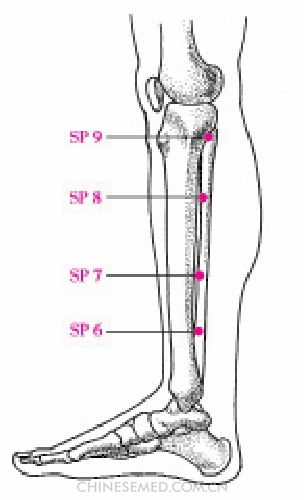
Actions. Invigorate the spleen and stomach, boost the liver and kidney, and regulate menstruation and leukorrhea.
Indications. Abdominal pain and distention, stomachache, diarrhea, spleen and stomach weakness, hiccup, jaundice, cholera, indigestion; irregular menstruation, dysmenorrhea, menostasis, leukorrhea, prolapse of the uterus, prolonged labor, infertility, abdominal mass, postpartum bruising, lochia; difficulty urinating, enuresis, edema, spermatorrhea, retention of urine, prolapse of uterus, nocturnal emission, impotence, hernia, testes contracted into the abdomen; insomnia, mania, infantile convulsions; atrophy and paralysis of the legs, tinea pedis, neurodynia of lower limbs, paralysis.
Manipulation. Acupuncture: 1. Needle perpendicularly 0.5~1.0 cun. Local soreness, numbness, and electric sensations spread to the sole of the foot, or soreness spreads to the knee and medial aspect of the thigh. 2. Needle perpendicularly 1.5~2.5 cun toward GB 39 (xuán zhōng) to treat foot disorders. Local soreness or numbness and electric sensations should spread to the sole of the foot. 3. Needle obliquely 1.5~2.5 cun with the needle tip upward to treat disorders of the body. Local soreness, and sometimes numbness and electric sensations, spread to the knee and medial aspect of the thigh. 4. Use the dragon-tiger fighting method to regulate qi and relieve pain. 5. Use the stem-branch grinding-mortar method to alleviate edema by inducing diuresis. Moxibustion: Use 5~9 cones of cone moxibustion, or use warming needle moxibustion for 20 minutes, or use a moxa stick for 10~20 minutes. Scarring moxibustion may be used once a year to promote health, or use up to 100 cones of cone moxibustion for that purpose. Natural and medicinal moxibustion may also be used.
Precautions. This point is contraindicated in pregnancy.
Annotation. The point appeared in The Systematic Classic of Acupuncture and Moxibustion (ZhēnJiŭ Jiă Yĭ Jīng, 针灸甲乙经). It is the intersecting point of the foot three yin channels, so it was named sān yīn jiāo, three yin crossing.
Modern clinical observation and research. In a multicenter RCT to assessed the importance of point specificity in treating TCM patterns, 501 women with primary dysmenorrhea (PD) were divided into three EA treatment groups and given SP 6 (sān yīn jiāo), GB 39 (xuán zhōng), or an adjacent non-acupoint. When the differentiation was damp cold stagnation, the SP 6 group had a significant reduction in VAS scores compared to those receiving the other two points, suggesting that TCM pattern should infuence point specificity.1
SP 7 (Lòu Gǔ, 漏谷)
Location. On the tibial aspect of the leg posterior to the medial border of the tibia, 6 cun superior to the prominence of the medial malleolus (Pic. 3-27).
Actions. Invigorate spleen, harmonize the stomach, induce diuresis, and remove dampness.
Indications. Abdominal distention, borborygmus, abdominal pain, diarrhea, indigestion, spleen and stomach weakness; difficulty in urinating, enuresis, spermatorrhea, nocturnal emission, impotence, contraction of the testis into the abdomen; atrophy and paralysis of the legs, beriberi, impediment pain, neurodynia of the lower limbs, paralysis.
Manipulation. Acupuncture: Needle perpendicularly 1.0~1.5 cun. Local soreness can spread to the lateral aspect of the tibia. Moxibustion: Use 3~5 cones of cone moxibustion, or use warming needle moxibustion for 20 minutes, or treat 5~10 minutes with a moxa stick.
Precautions. Avoid injuring the posterior tibial artery and vein when needling deeply.
Annotation. The point is recorded in The Systematic Classic of Acupuncture and Moxibustion (Zhēn Jiŭ Jiă Yĭ Jīng, 针灸甲乙经). Lòu means leakage and gǔ refers to a depression. This point can treat urinary difficulty, immobility due to damp arthralgia, and spotting, and it induces dieresis.
SP 8 (Dì Jī, 地机)
Xi-cleft point
Location. On the tibial aspect of the leg posterior to the medial border of the tibia, 3 cun inferior to SP 9 (yīn líng quán) (Pic. 3-27).
Actions. Invigorate the spleen, expel dampness, regulate menstruation, and stop leukorrhagia.
Indications. Abdominal distention, abdominal pain, diarrhea, poor appetite, dysentery; difficulty in urinating, edema; irregular menstruation, dysmenorrhea, uterine bleeding, leukorrhagia; atrophy, paralysis and pain in the leg and knee.
Manipulation. Acupuncture: Needle perpendicularly 1.0~1.5 cun. Local soreness can spread to the lower leg. Moxibustion: Use 3~5 cones of cone moxibustion, or 5~10 minutes of warming needle moxibustion, or 5~10 minutes with a moxa stick.
Precautions. See SP 7 (lòu gŭ).
Annotation. The point is recorded in The Systematic Classic of Acupuncture and Moxibustion (Zhēn Jiŭ Jiă Yĭ Jīng, 针灸甲乙经). Dì means earth, which refers to spleen channel; jī means key. This is the xi-cleft point of foot taiyin, and the main point where its qi gathers.
SP 9 (Yīn Líng Quán, 阴陵泉)
He-sea point
Location. On the tibial aspect of the leg in the depression between the inferior border of the medial condyle of the tibia and the medial border of the tibia (Pic. 3-27).
1 Liu YQ, Ma LX, Xing JM, Cao HJ, Wang YX, et al. Does traditional Chinese medicine pattern affect acupoint specific effect? Analysis of data from a multicenter, randomized, controlled trial for primary dysmenorrhea. J Altern Complement Med. 2013; 19(1): 43-9.
Location method. Use the thumb to push proximally along the medial border of the tibia; the point is in the depression inferior to the tibial condyle.
Actions. Clear heat, drain dampness, invigorate the spleen, regulate qi, nourish the kidney, regulate menstruation, unblock channels, and quicken collaterals.
Indications. Abdominal distention, diarrhea, jaundice, abdominal pain, poor appetite, cholera; difficulty urinating, edema, incontinence, enuresis, spermatorrhea, impotence; irregular menstruation, dysmenorrhea, leukorrhagia; eczema, nettle-rash, scabies; knee pain, tinea pedis, paralysis; palpitations, somnolence, dizziness, headache, cough with abundant phlegm.
Manipulation. Acupuncture: Needle perpendicularly 1.0~1.5 cun. Local soreness can spread to the lower leg. Moxibustion: Use 3~5 cones of cone moxibustion or 5~10 minutes of warming needle moxibustion, or use a moxa stick for 5~10 minutes.
Precautions. In deep puncturing, avoid the tibial artery and vein.
Annotation. The point appeared in The Spiritual Pivot (Líng Shū, 灵枢). Called yin spring mound, it is on the medial side of the leg, which belongs to yin. The medial condyle of the tibia protrudes like a mound, and the depression below the condyle is like an area where a spring would be located.
SP 10 (Xuè Hǎi, 血海)
Location. On the anteromedial aspect of the thigh 2 cun superior to the medial end of the base of the patella on the bulge of the vastus medialis muscle (Pic. 3-28).

Location method. With the patient’s knee flexed, put the center of your palm on the patella, thumb toward the medial aspect of the leg. The point is beneath the thumb tip.
Actions. Regulate menstruation, control blood, invigorate the spleen, and resolve dampness.
Indications. Irregular menstruation, heavy uterine bleeding, dysmenorrhea, leukorrhagia, lochia, abdominal masses in women; urticaria, eczema, erysipelas; scabies; knee pain, pain in the medial aspect of the thigh, tinea pedis, paralysis.
Manipulation. Acupuncture: Needle perpendicularly 1.0~ 2.0 cun. Local soreness can spread to the patella. Moxibustion: Use 5~7 cones of cone moxibustion, or 10~20 minutes of warming needle moxibustion, or use a moxa stick for 10~20 minutes.
Annotation. The point is recorded in The Systematic Classicof Acupuncture and Moxibustion (Zhēn Jiŭ Jiă Yĭ Jīng, 针灸甲乙经). The spleen controls blood and warms the fve zang organs; this point is where qi of the foot taiyin channel originates and forms the sea where qi and blood gather.
Modern clinical observation and research. A 26-year-old woman with amenorrhea did not fully respond to hormone therapy or acupuncture alone. After two weeks of hormone replacement plus regular acupuncture treatment with SP 10 and other classical points for menstrual disorders, blood flow resumed. Within three months, her body had moved closer to the normal biphasic pattern.1
1 Donoyama N, Hotoge S, Ohkoshi N. Acupuncture might have contributed to improving amenorrhoea in a top athlete. Acupunct Med. 2011; 29(4): 304-6.
SP 11 (Jī Mén, 箕门)
Location. On the medial aspect of the thigh between the sartorius muscle and the adductor longus muscle, over the femoral artery and at the junction of the upper one third and lower two thirds of a line connecting the medial end of the base of the patella and SP 12 (chōng mén) (Pic. 3-28).
Location method. With the patient upright with the knee flexed or supine with legs slightly apart, the point is on the medial border of the sartorius muscle 6 cun above SP 10 (xuè hăi).
Actions. Invigorate the spleen, expel dampness, and unblock the lower jiao.
Indications. Dysuria, enuresis, strangury, eczema in the scrotum, swelling and pain of the groin.
Manipulation. Acupuncture: Needle perpendicularly 0.3~1.0 cun. Local soreness can spread upward to the medial aspect of the thigh or downward to the ankle. Twirl to reinforce or reduce. Moxibustion: Use 3~5 cones of cone moxibustion, or 5~10 minutes of warming needle moxibustion, or use a moxa stick for 5~10 minutes.
Annotation. The point appeared in The Systematic Classic of Acupuncture and Moxibustion (Zhēn Jiŭ Jiă Yĭ Jīng, 针灸甲乙经). Jī means winnowing fan. When the two knees are separated like a winnowing fan, SP 11 (jī mén) on the inner thighs is like a gate to the winnower.
SP 12 (Chōng Mén, 冲门)
Intersecting point of yinwei, foot taiyin, and foot jueyin channels
Location. In the groin region at the inguinal crease, lateral to the femoral artery (Pic. 3-28, Fig. 3-29).
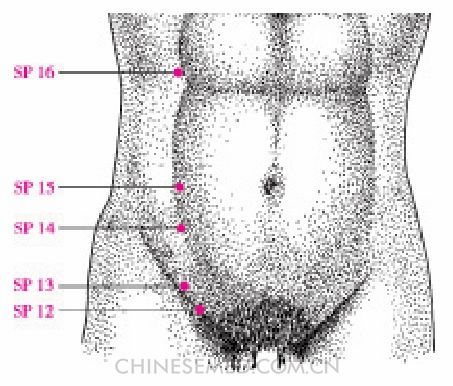
Location method. With the patient supine, fnd the point 3.5 cun lateral to RN 2 (qū gŭ).
Actions. Invigorate the spleen, expel dampness, regulate qi, and arrest convulsion.
Indications. Abdominal pain, abdominal distention; dysuria, edema, hernia, hemorrhoid pain; counterflow of fetal qi, nausea, leukorrhea, postpartum hemorrhage, lochia, abdominal masses in women.
Manipulation. Acupuncture: Needle perpendicularly 0.5~1.0 cun; avoid the artery. Soreness in the inguinal groove can spread to the external genitalia. Moxibustion: Use 3~5 cones of cone moxibustion, or 10~20 minutes of warming needle moxibustion, or use a moxa stick for 10~20 minutes.
Precautions. Do not puncture the parietal peritoneum or you will pierce the abdominal cavity. Avoid the viscera, external iliac artery and vein, and femoral artery and vein, which are superior and inferior to the inguinal ligament.
Annotation. This point appeared in The Systematic Classic of Acupuncture and Moxibustion (ZhēnJiŭ Jiă Yĭ Jīng, 针灸甲乙经). Called penetrating gate, it is on the lateral aspect of the inguinal groove where the pulsing artery can be felt and spleen channel qi rushes up to enter the abdomen.
SP 13 (Fǔ Shè, 府舍)
Intersecting point of the yinwei, foot taiyin, jueyin, shaoyin, and yangming channels
Location. On the lower abdomen 4.3 cun inferior to the center of the umbilicus, 4 cun lateral to the anterior median line (Pic. 3-29).
Actions. Invigorate the spleen, regulate qi, dissipate masses, and relieve pain.
Indications. Abdominal pain, cholera, hernia, distention, and abdominal masses.
Manipulation. Acupuncture: Needle perpendicularly 1.0~1.5 cun. Local soreness can spread to the external genitalia. Moxibustion: Use 3~5 cones of cone moxibustion, or use warming needle moxibustion for 20 minutes, or use a moxa stick for 5~10 minutes.
Precautions. Depth of insertion depends on the thickness of the abdominal wall. To avoid puncturing the internal organs, do not pierce the peritoneum.
Annotation. The point is recorded in The Systematic Classic of Acupuncture and Moxibustion (Zhēn Jiŭ Jiă Yĭ Jīng, 针灸甲乙经). Fǔ means gathering and shè means house. The point is where qi and blood of fve channels gather and converge.
SP 14 (Fù Jié, 腹结)
Location. On the lower abdomen 1.3 cun inferior to the center of the umbilicus, 4 cun lateral to the anterior median line (Pic. 3-29).
Actions. Invigorate the spleen, warm the middle, diffuse and direct counterflowing qi downward.
Indications. Abdominal pain around the umbilicus, diarrhea, hernia.
Manipulation. Acupuncture: Needle perpendicularly 1.0~1.5 cun. There should be local soreness, numbness, and heaviness. Moxibustion: Use 3~5 cones of cone moxibustion, 5~10 minutes with a moxa stick, or warming needle moxibustion.
Precautions. See SP 13 (fŭ shè).
Annotation. The point is recorded in The Systematic Classic of Acupuncture and Moxibustion (Zhēn Jiŭ Jiă Yĭ Jīng, 针灸甲乙经). Fù refers to the lower abdomen; jié means gathering. Abdominal qi gathers at this point.
SP 15 (Dà Héng, 大横)
Intersecting point of the foot taiyin and yinwei channels
Location. On the upper abdomen 4 cun lateral to the center of the umbilicus (Pic. 3-29).
Actions. Warm the middle jiao, dissipate cold, regulate the intestines and stomach.
Indications. Abdominal pain, abdominal distention, diarrhea, constipation, dysentery; atrophy of the four limbs, palpitations due to fright, severe palpitations.
Manipulation. Acupuncture: 1. Needle perpendicularly 1.0~1.5 cun. 2. Needle transversely 2.0~2.5 cun toward RN 8 (shén què) to treat intestinal parasites. Local soreness can spread to the abdomen on the side needled. Moxibustion: Use 5~7 cones of cone moxibustion or 10~20 minutes of warming needle moxibustion.
Precautions. See SP 13 (fŭ shè).
Annotation. The point is recorded in The Systematic Classic of Acupuncture and Moxibustion (Zhēn Jiŭ Jiă Yĭ Jīng, 针灸甲乙经). Dà means big; héng means horizontal or level. The point is level with the umbilicus.
SP 16 (Fù Āi, 腹哀)
Intersecting point of the foot taiyin and the yinwei channel
Location. On the upper abdomen 3 cun superior to the center of the umbilicus, 4 cun lateral to the anterior median line (Pic. 3-29).
Actions. Invigorate the spleen, harmonize the intestines and stomach, and regulate qi.
Indications. Pain around the umbilicus, dysentery, constipation, dyspepsia.
Manipulation. Acupuncture: Needle perpendicularly 1.0~1.5 cun. There will be local soreness, numbness, heaviness, and distention. Moxibustion: Use 3~5 cones of cone moxibustion, or use 5~10 minutes with a moxa stick, or warming needle moxibustion.
Precautions. Deep insertion is prohibited. Do not lift or thrust. Depth of insertion depends on the thickness of the abdominal wall; do not penetrate the peritoneum. Puncturing the colon can cause infection in the abdominal cavity; puncturing the liver can cause bleeding.
Annotation. The point is recorded in The Systematic Classic of Acupuncture and Moxibustion (Zhēn Jiŭ Jiă Yĭ Jīng, 针灸甲乙经). Fù means abdomen; āi means sorrow and refers to unbearable pain in this instance. This point treats unbearable abdominal pain that causes the patient to moan.
SP 17 (Shí Dòu, 食窦)
Location. In the anterior thoracic region in the fifth intercostal space, 6 cun lateral to the anterior median line (Pic. 3-30).
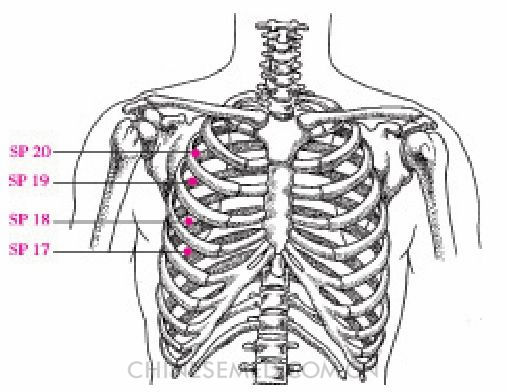
Location method. The point is level with ST 18 (rŭ gēn), KI 22 (bù láng), and RN 16 (zhōng tíng). These four points form an arc that corresponds to the arc of the fifth intercostal space.
Actions. Diffuse the lung and relieve panting, invigorate the spleen, harmonize the middle jiao, and drain water to relieve edema.
Indications. Abdominal distention, edema, distention and pain in chest and hypochondrium, dysentery, constipation, pain in the lower abdomen, insomnia due to chest pain that radiates to the back, difficult urination.
Manipulation. Acupuncture: Needle transversely or obliquely outward 0.5~0.8 cun.There should be local soreness and distention. Moxibustion: Use 3~5 cones of cone moxibustion or 5~10 minutes with a moxa stick.
Precautions. See ST 14 (kù fáng).
Annotation. The point is recorded in The Systematic Classic of Acupuncture and Moxibustion (Zhēn Jiŭ Jiă Yĭ Jīng, 针灸甲乙经). Shí means food; dòu means hole. This point is where food enters the stomach and spleen. It is responsible for the transportation and transformation of water and food and for harmonizing the stomach and lower qi.
SP 18 (Tiān Xī, 天溪)
Location. In the anterior thoracic region in the fourth intercostal space, 6 cun lateral to the anterior median line (Pic. 3-30).
Location method. The point is level with ST 17 (rŭ zhōng), KI 23 (shén fēng), and RN 17 (dànzhōng). The four points form an arc that corresponds to the arc of the fourth intercostal space.
Actions. Loosen the chest, regulate qi, relieve cough, and stimulate lactation.
Indications. Chest pain, cough, distention and pain in the chest and hypochondrium, insomnia due to chest pain leading to back pain; acute mastitis, Insufficient lactation, intercostal neuralgia.
Manipulation. Acupuncture: Needle 0.5~0.8 cun transversely or obliquely. There should be local soreness and distention. Moxibustion: Use 3~5 cones of cone moxibustion, or 5~10 minutes with a moxa stick.
Precautions. See ST 14 (kù fáng).
Annotation. The point is recorded in The Systematic Classic of Acupuncture and Moxibustion (Zhēn Jiŭ Jiă Yĭ Jīng, 针灸甲乙经). Tiān means sky, or upper part in this instance; xī refers to the depression between the two ribs as well as to its function as it stimulates lactation which is like a smoothly flowing stream.
SP 19 (Xiōng Xiāng, 胸乡)
Location. In the anterior thoracic region in the third intercostal space, 6 cun lateral to the anterior median line (Pic. 3-30).
Location method. Level with ST 16 (yīng chuāng), KI 24 (líng xū), and RN 18 (yù táng). The four points form an arc that corresponds to the arc of the third intercostal space.
Actions. Diffuse the lung, relieve cough, regulate qi, and relieve pain.
Indications. Distention and pain in the chest and hypochondrium, cough, insomnia due to chest pain that radiates to the back.
Manipulation. Acupuncture: Needle obliquely or transversely outward 0.5~0.8 cun. There should be local soreness and distention. Moxibustion: Use 3~5 cones of cone moxibustion or 5~10 minutes with a moxa stick.
Precautions. See ST 14 (kù fáng).
Annotation. The point is recorded in The Systematic Classic of Acupuncture and Moxibustion (Zhēn Jiŭ Jiă Yĭ Jīng, 针灸甲乙经).
SP 20 (Zhōu Róng, 周荣)
Location. In the anterior thoracic 6 cun lateral to the anterior median line region in the second intercostal space (Pic. 3-30).
Location method. The point is level with ST 15 (wū yì), KI 25 (shén cáng), and RN 19 (zĭgōng). The four points form an arc that corresponds to the arc of the second intercostal space.
Actions. Diffuse the lung, relieve asthma, regulate qi, and reduce phlegm.
Indications. Distention and pain in the chest and hypochondrium, cough, asthma, poor appetite.
Manipulation. Acupuncture: Needle obliquely or transversely outward 0.5~0.8 cun. There should be local soreness and distention. Moxibustion: Use 3~5 cones of cone moxibustion, or 5~10 minutes with a moxa stick.
Precautions. Depth of insertion depends on the thickness of the pectoral muscle. Deep insertion is forbidden and may cause pneumothorax. It is inadvisable to lift, thrust, or twirl the needle. See also ST 14 (kù fáng).
Annotation. The point is recorded in The Systematic Classic of Acupuncture and Moxibustion (Zhēn Jiŭ Jiă Yĭ Jīng, 针灸甲乙经). Zhōu means circle; róng means nourish. At this point, spleen qi disperses essence to the lung, which spreads qi to nourish the whole body.
SP 21 (Dà Bāo, 大包)
Major collateral of the spleen
Location. In the lateral thoracic region on the midaxillary line in the sixth intercostal space (Pic. 3-31).
Location method. With the patient lying on the side and the arm abducted, the point is at the intersection of the midaxillary line and the sixth intercostal space.
Actions. Loosen the chest, boost the spleen, and regulate qi and blood.
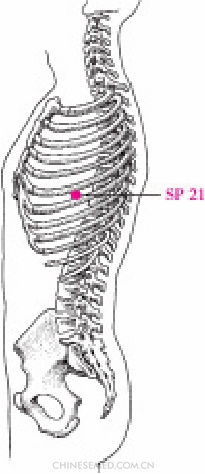
Indications. Chest and hypochondriac pain, asthma; pain of whole body; pain in the chest when breathing; lethargy of the four limbs.
Manipulation. Acupuncture: 1. Needle obliquely or transversely backward 0.5~0.8 cun. There should be local soreness and distention. 2. Needle obliquely upward to treat neck sprain. There will be local soreness and distention. Moxibustion: Use 3~5 cones of cone moxibustion, or 5~10 minutes with a moxa stick.
Precautions. The depth of insertion depends on the thickness of the chest wall. Deep insertion is forbidden to prevent pneumothorax. See also ST 14 (kù fáng).
Annotation. The point is recorded in The Systematic Classic ofAcupuncture and Moxibustion (Zhēn Jiŭ Jiă Yĭ Jīng, 针灸甲乙经). It is the major collateral of the spleen and controls yin and yang of all the channels.
Modern clinical observation and research. In a case series on compression of lateral cutaneous intercostal nerves, 36 patients were given acupuncture once a day for ten days. On the affected side, SP 6 (sānyīn jiāo), then SP 21 (dà bāo) were needled and retained for 20 minutes. Needles were twirled every 5 minutes to reinforce or reduce based on syndrome differentiation. Treatment was more effective in those with acute conditions.

